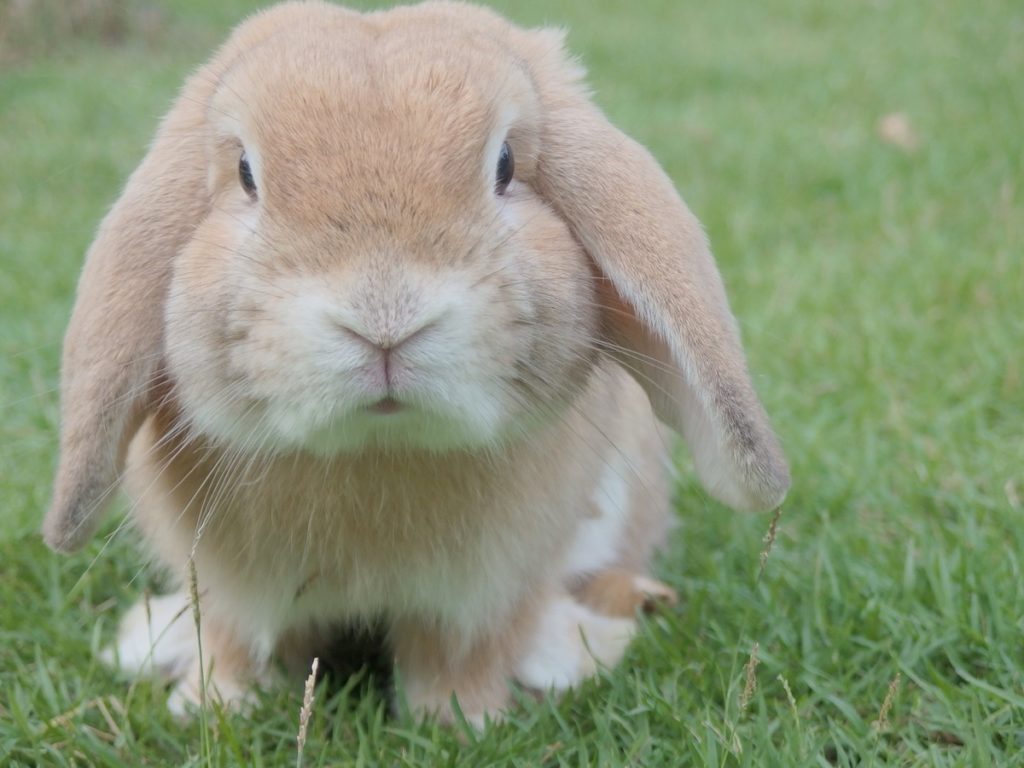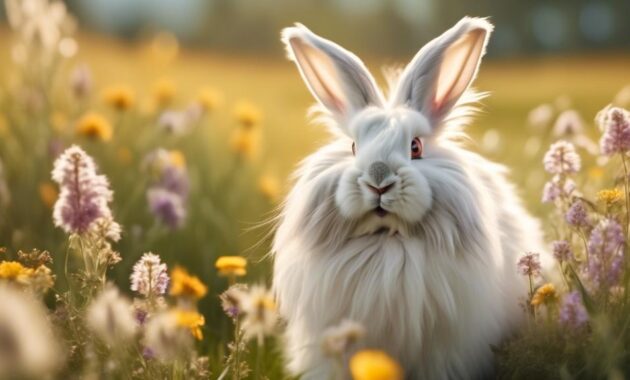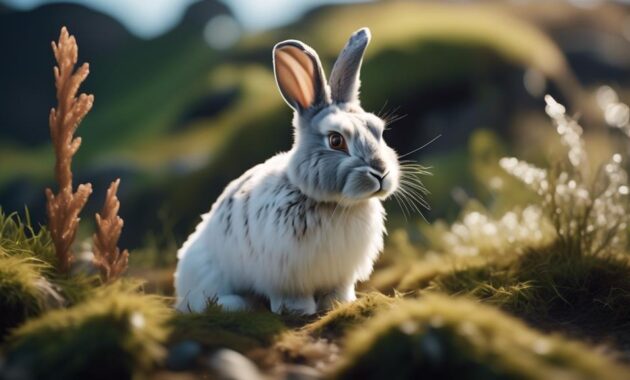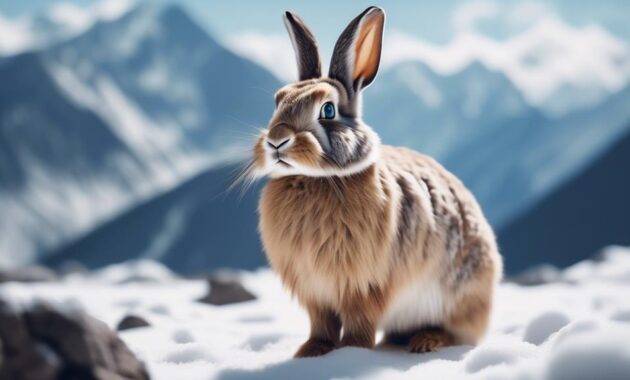Have you ever touched a cloud? Imagine the softness, the smoothness, and the sheer delight of running your fingers through its ethereal texture.
Now, imagine a rabbit with a coat so lustrous and silky that it rivals the touch of a cloud. Satin rabbits, with their enchanting sheen and captivating beauty, are truly a sight to behold.
But there is so much more to these silky-coated beauties than meets the eye. From their fascinating history to their unique care requirements, there is a world of wonder awaiting you.
So, come along as we uncover the secrets behind the satin rabbit's mesmerizing allure.
Key Takeaways
- Satin rabbits have a silky, short, rollback fur with a satin sheen, which is a result of a recessive sheen gene.
- Satin rabbits come in eleven coat colorations, including black, blue, chinchilla, and white.
- Satin rabbits require minimal coat maintenance, with brushing during heavy molting being sufficient.
- Satin rabbits need daily socialization, a well-balanced diet, and regular check-ups to ensure their health and well-being.
Satin Rabbit Description
The Satin Rabbit is a breed known for its silky coat and medium size. It typically weighs between 8.5 and 11 pounds and has a lifespan of 7 to 9 years.
The breed has a commercial body shape and is comparable to breeds like the Havana Rabbit and the Mini Satin Rabbit. It originated from Mr. Walter Hueys rabbitry, with the first litter of Satin rabbits. Initially, Satin Havanas were shown alongside other Havanas, but later on, they were recognized as their own breed by the American Rabbit Breeders Association in 1956 and sponsored by the American Federation of Havana Breeders.
The Satin Rabbit has a unique coat. It has silky, short, rollback fur that has a satin sheen. This coat is the result of a recessive sheen gene, with each hair follicle being slightly smaller in diameter and containing tiny air bubbles inside. Despite its luxurious appearance, the Satin Rabbit's coat requires minimal maintenance. It only needs occasional brushing during heavy molts.
Satin Rabbit Breed History
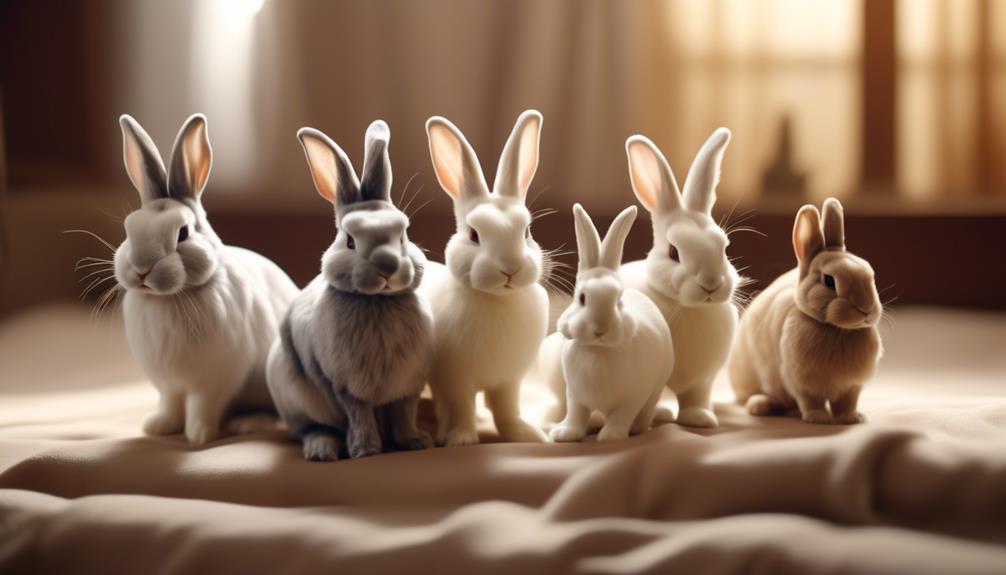
To understand the origins of the Satin Rabbit breed, let's delve into its fascinating history.
- The first litter of Satin rabbits came from Mr. Walter Huey's rabbitry.
- Satin Havanas were initially placed in shows against other Havanas.
- The American Federation of Havana Breeders sponsored Satin Havanas as its own breed, and the Satin rabbit was recognized by the American Rabbit Breeders Association in 1956.
These three milestones mark the development and recognition of the Satin Rabbit breed.
From its humble beginnings in Mr. Walter Huey's rabbitry to being showcased in competitions, the Satin Rabbit breed has come a long way. Thanks to the efforts of the American Federation of Havana Breeders, Satin Havanas were given their own category, solidifying their status as a distinct breed. Finally, in 1956, the American Rabbit Breeders Association officially recognized the Satin rabbit, solidifying its place in the rabbit community.
Satin Rabbit Coat
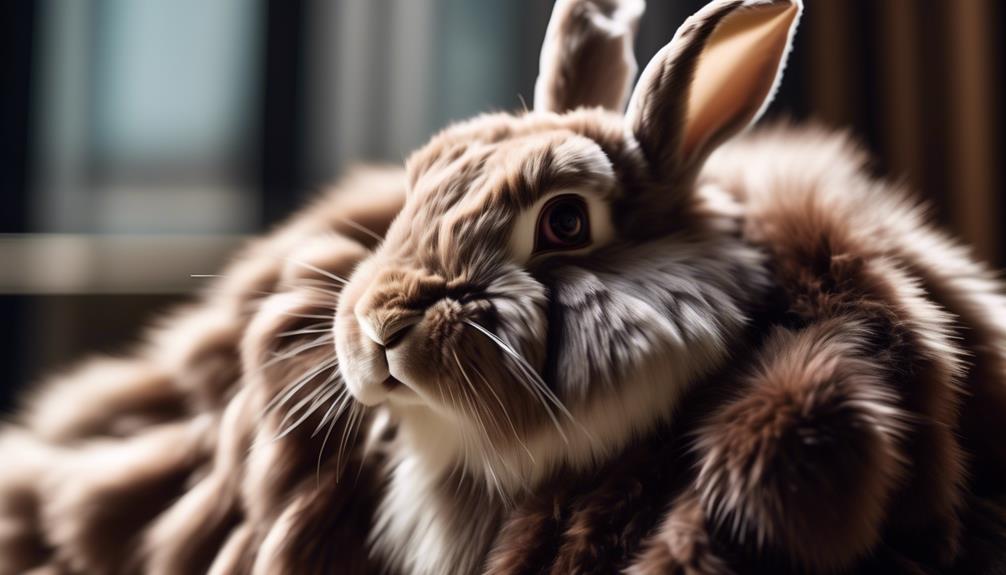
With its silky, short, rollback fur and satin sheen, the Satin Rabbit's coat is a true marvel. This beautiful coat is the result of a recessive sheen gene, which gives the fur its unique qualities. Each hair follicle is slightly smaller in diameter and contains tiny air bubbles, creating the smooth and shiny appearance.
One of the best things about the Satin Rabbit's coat is that it requires minimal maintenance. During heavy molting, simply brushing with a slicker brush or running damp hands through the coat is enough to keep it looking its best.
The Satin Rabbit comes in a variety of colors, including black, blue, chinchilla, and more, making it a visually stunning breed.
Satin Rabbit Colors
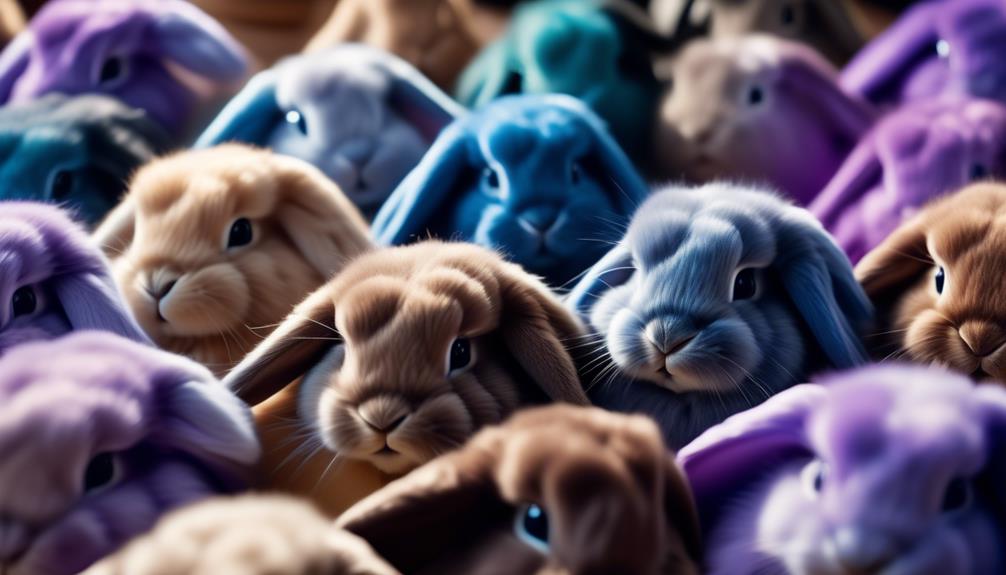
When it comes to the colors of Satin Rabbits, you'll be amazed by the stunning variety they come in. These beautiful creatures can be found in a range of eleven coat colorations. Here are three of the captivating colors you might encounter:
- Black: This deep and rich color gives Satin Rabbits a sleek and sophisticated appearance.
- Blue: With a soft and powdery hue, blue Satin Rabbits exude an air of tranquility and elegance.
- Californian: The striking contrast between their white bodies and dark-colored ears, nose, and feet makes Californian Satin Rabbits truly eye-catching.
Whether you prefer the classic beauty of black, the delicate charm of blue, or the captivating contrast of Californian, Satin Rabbits are sure to impress with their diverse and enchanting coat colors.
Satin Rabbit Care Requirements
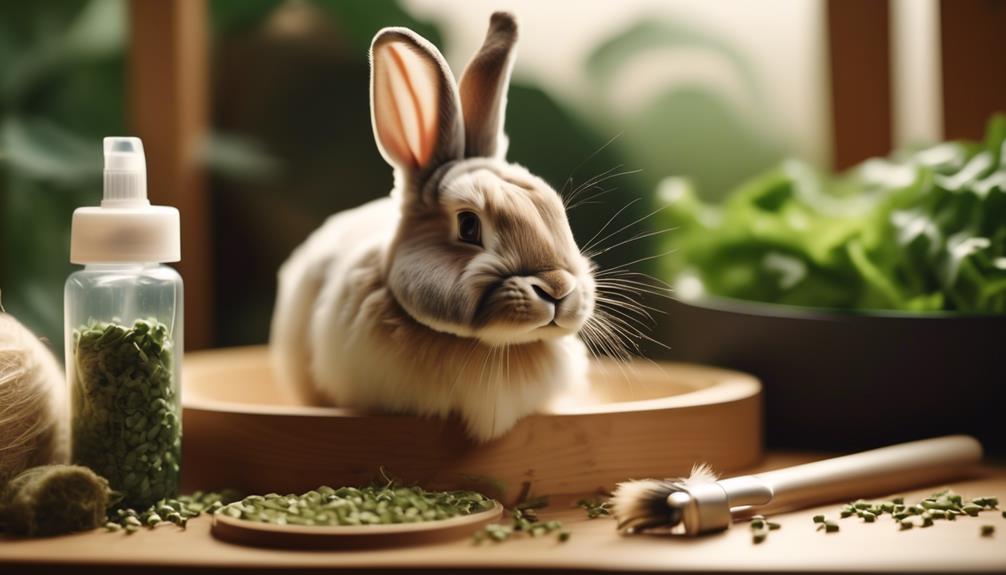
Now let's shift our focus to the essential care requirements for Satin Rabbits, ensuring they live happy and healthy lives.
Daily socialization outside of the enclosure is crucial for their well-being.
Make sure their indoor enclosure has wire walls and a solid bottom, while outdoor enclosures should be protected from the elements.
It's important to spot-clean the bedding daily and completely replace it on a weekly basis.
A well-balanced diet should consist of 70% hay and 30% leafy greens, fruits, and vegetables.
Regular check-ups are necessary to monitor their health, including Vitamin D deficiency, earwax buildup, overgrown teeth, and soiled fur.
Weight and Lifespan
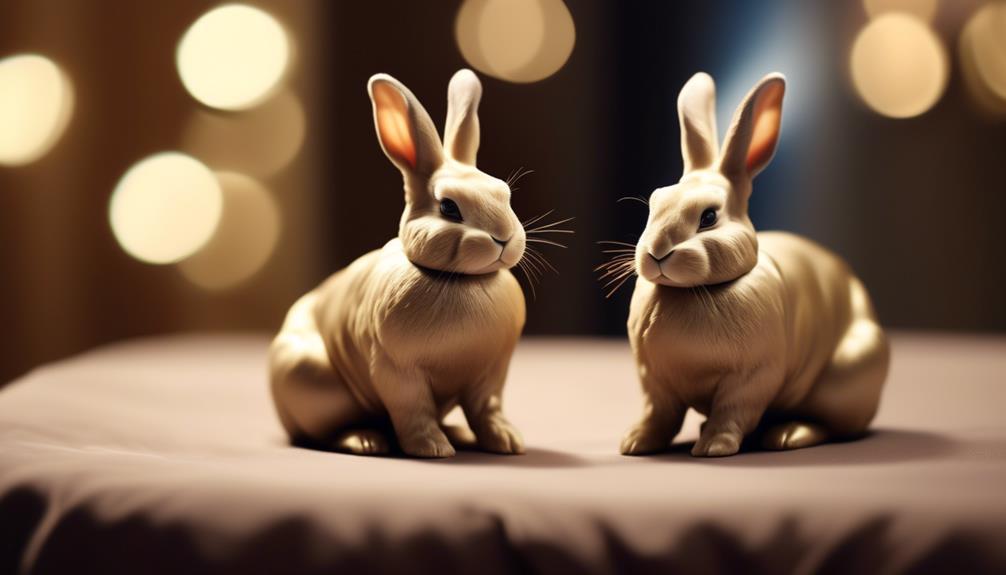
Satin Rabbits typically weigh between 8.5 and 11 pounds and have a lifespan of 7 to 9 years.
Here are three important things to know about their weight and lifespan:
- Weight Range: Satin Rabbits fall within the weight range of 8.5 to 11 pounds, making them a medium-sized breed.
- Lifespan: These beautiful rabbits can live for an average of 7 to 9 years, providing years of companionship.
- Healthy Maintenance: Maintaining a balanced diet and providing regular check-ups can contribute to a longer lifespan for your Satin Rabbit.
Keeping these factors in mind will help you ensure the overall well-being and longevity of your Satin Rabbit companion.
Body Shape and Size
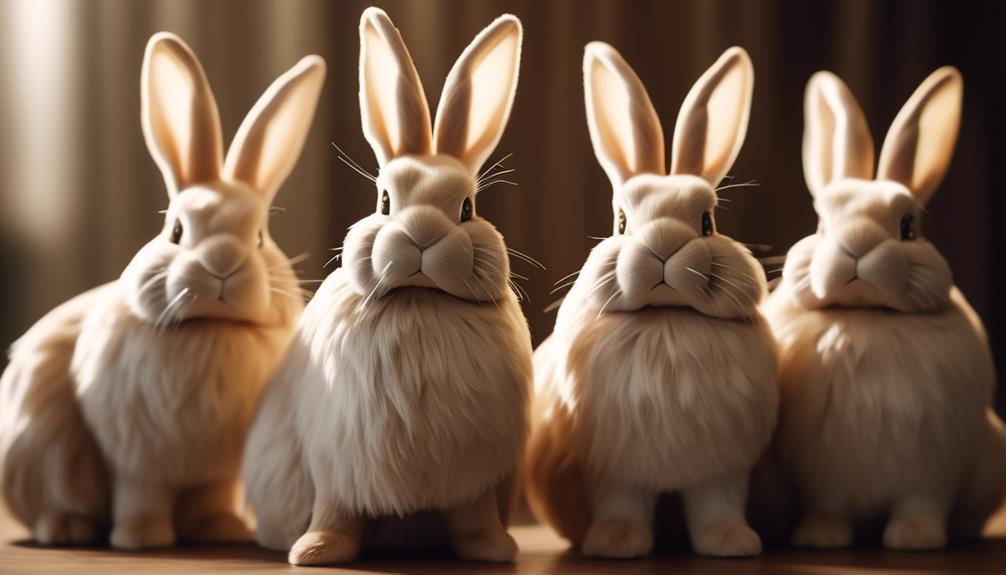
After learning about the weight and lifespan of Satin Rabbits, let's now explore their body shape and size.
Satin rabbits have a commercial body shape, which is medium in size. They aren't too big or too small, making them a great choice for those who want a rabbit that isn't too demanding in terms of space.
Their bodies are well-muscled and compact, with a rounded appearance. Satin rabbits have a broad chest and a short, strong neck. Their legs are straight and muscular, giving them a sturdy and balanced stance.
Comparable Breeds
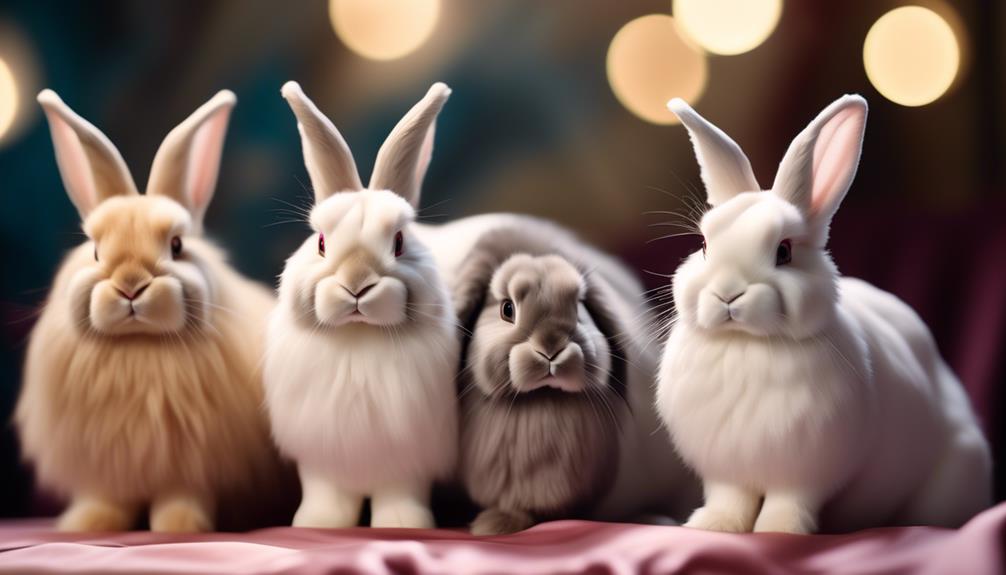
Let's explore some rabbit breeds that are comparable to Satin rabbits. Here are three breeds that share similarities with Satins:
- Havana Rabbit: Like Satins, Havanas have a silky coat and a medium size. They also come in various colors, including black, chocolate, and blue. However, Havanas have a denser and longer coat compared to Satins.
- Mini Satin Rabbit: As the name suggests, Mini Satins are a smaller version of Satins. They've the same silky coat and beautiful sheen, but in a more compact size. Mini Satins also come in a variety of colors, just like their larger counterparts.
- Rex Rabbit: While Rex rabbits have a different coat texture, they share a similar medium size and are known for their soft and velvety fur. Rex rabbits come in various colors and have a dense, plush coat that's different from the Silky coat of Satins.
These comparable breeds offer rabbit enthusiasts a range of choices with similar features to the stunning Satin rabbits.
Origin of Satin Rabbits
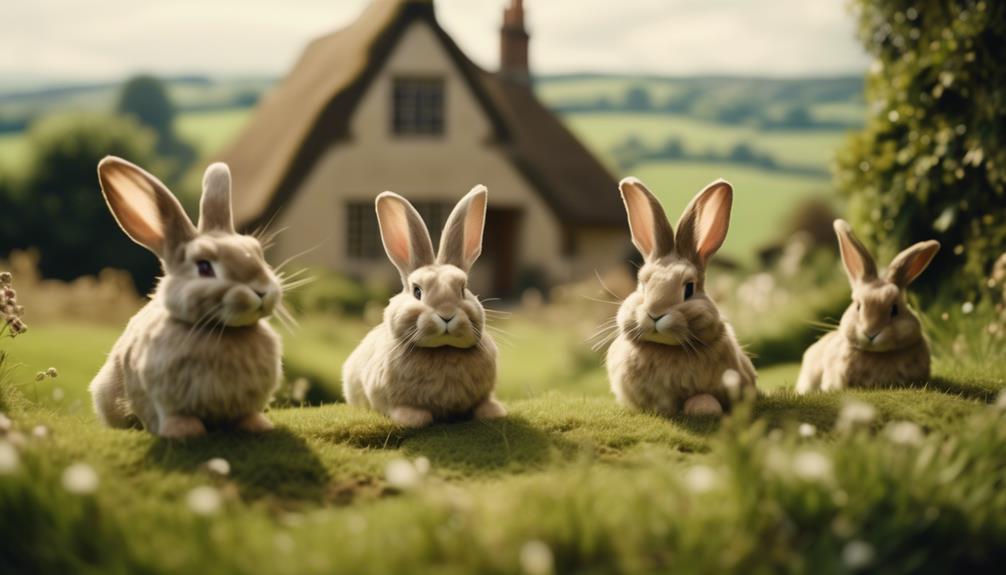
As we continue our exploration of rabbit breeds comparable to Satin rabbits, it's interesting to uncover the origin of these captivating creatures. The first litter of Satin rabbits came from Mr. Walter Huey's rabbitry.
Initially, Satin Havanas were placed in shows alongside other Havanas. However, the American Federation of Havana Breeders sponsored Satin Havanas as their own breed.
It wasn't until 1956 that the Satin rabbit was officially recognized by the American Rabbit Breeders Association. The Satin rabbit's silky, short, rollback fur with a satin sheen is the result of a recessive sheen gene. Each hair follicle is slightly smaller in diameter with tiny air bubbles inside.
Despite their stunning coat, Satin rabbits require minimal maintenance, with brushing or running damp hands through the coat during heavy molt.
Recognition by ARBA
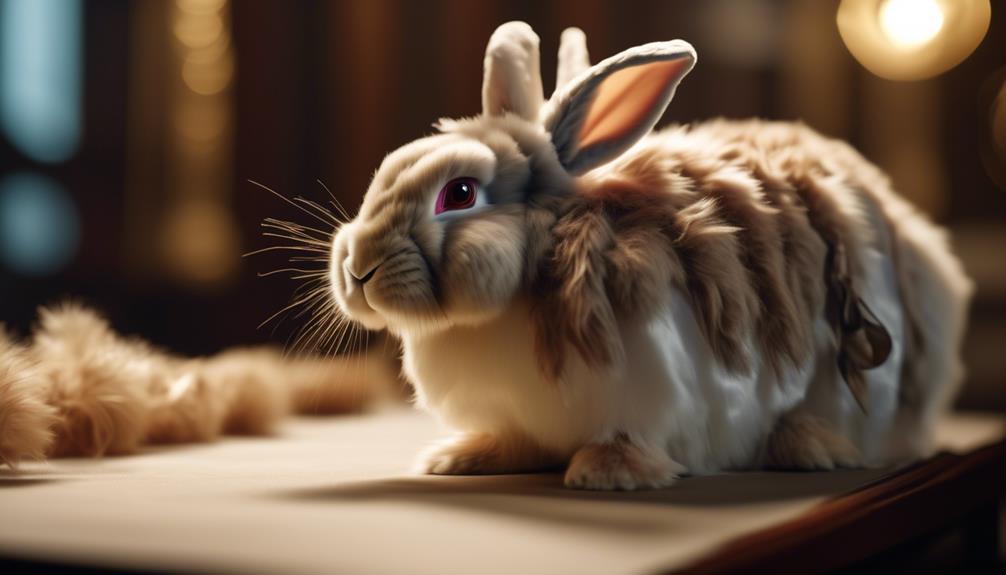
The American Rabbit Breeders Association officially recognized the Satin rabbit breed in 1956. This recognition by ARBA solidified the Satin rabbit's place in the rabbit breeding community and opened up opportunities for Satin breeders to showcase their rabbits in competitions and shows.
The recognition also brought attention to the unique qualities of the Satin rabbit, such as its silky, short, rollback fur with a satin sheen. With its distinctive coat, the Satin rabbit quickly became a favorite among rabbit enthusiasts.
Today, Satin rabbits are admired for their beautiful appearance and are appreciated for their minimal grooming requirements. Thanks to the recognition by ARBA, Satin rabbits continue to be cherished and enjoyed by rabbit lovers worldwide.
Characteristics of Satin Rabbit Coat
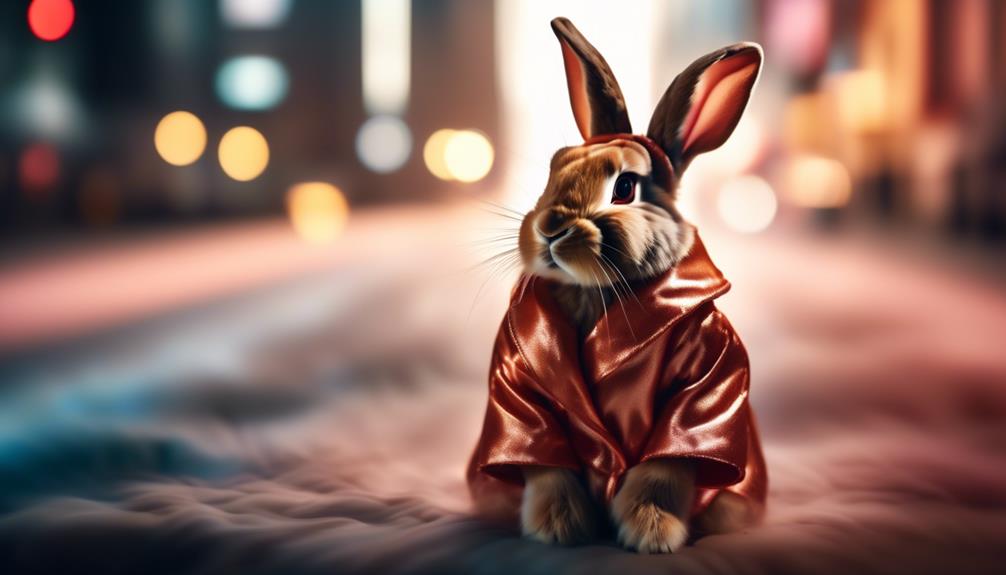
After being recognized by ARBA in 1956, the Satin rabbit's distinctive coat became a topic of fascination among rabbit enthusiasts worldwide. The Satin rabbit has a silky, short, and rollback fur with a satin sheen. This unique coat is the result of a recessive sheen gene.
Each hair follicle of the Satin rabbit is slightly smaller in diameter and contains tiny air bubbles inside. One of the advantages of this coat is that it requires minimal maintenance. During heavy molts, brushing with a slicker brush or running damp hands through the coat helps to keep it in good condition.
Satin Rabbit Coat Maintenance
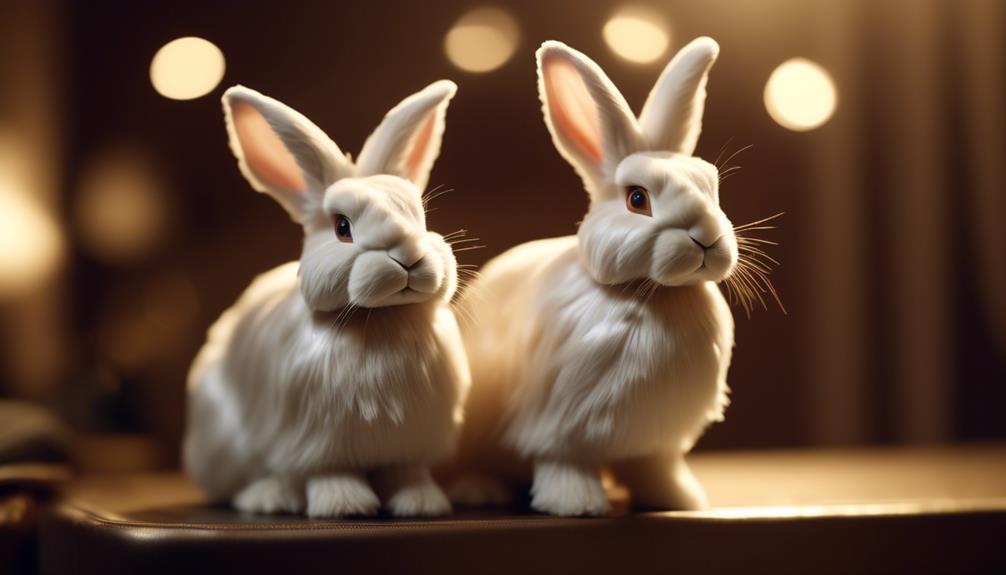
To maintain the beautiful coat of a Satin rabbit, regular grooming and proper care are essential. Here are three important steps to keep in mind:
- Brushing: Regular brushing with a slicker brush is crucial to remove any loose fur and prevent matting. Gently brush in the direction of hair growth to maintain the silky sheen of their coat.
- Bathing: Satin rabbits have a naturally clean coat and don't require frequent baths. However, if they get dirty, use a rabbit-safe shampoo and lukewarm water. Make sure to thoroughly dry their coat to avoid any dampness that could lead to skin issues.
- Diet and Nutrition: A healthy diet plays a significant role in maintaining a Satin rabbit's coat. Provide a balanced diet consisting of high-quality hay, fresh leafy greens, and a small amount of pellets to ensure they receive essential nutrients for a healthy coat.
Accepted Coat Colorations
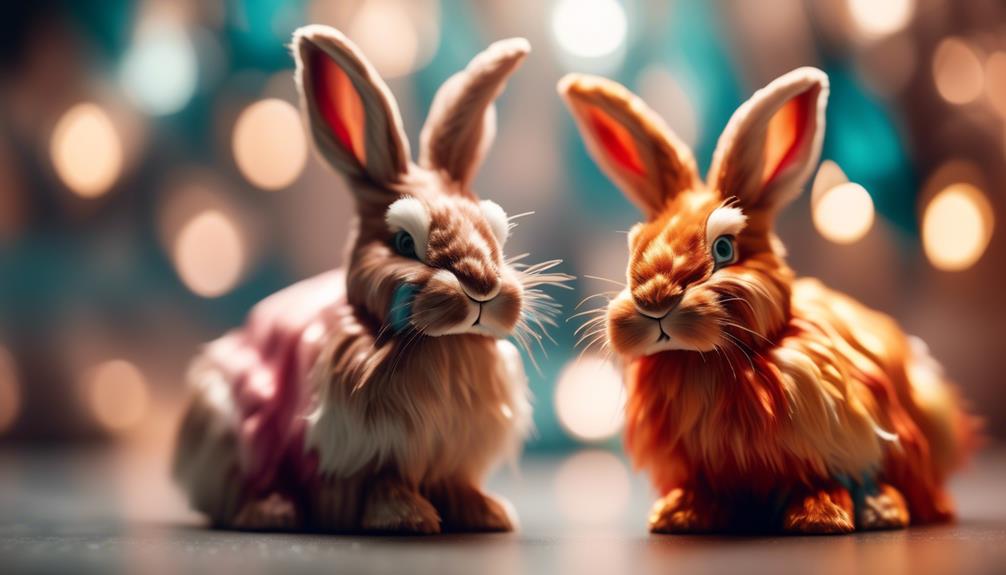
There are eleven coat colorations that are accepted for Satin rabbits, including black, broken, blue, californian, chinchilla, chocolate, copper, otter, red, white, and siamese. Each coloration adds its own unique charm to these silky-coated beauties. To help you visualize the different coat colorations, here is a table showcasing the accepted colors for Satin rabbits:
| Coat Colorations | Description | Example Image |
|---|---|---|
| Black | Solid black coat |  |
| Broken | Any color mixed with white |  |
| Blue | Diluted black coat |  |
| Californian | White body with black markings |  |
| Chinchilla | Agouti with black ticking |  |
| Chocolate | Dark brown coat |  |
| Copper | Coppery red coat |  |
| Otter | Colored body with white belly |  |
| Red | Bright red coat |  |
| White | Solid white coat |  |
| Siamese | Colored body with dark points |  |
With such a diverse range of coat colorations, Satin rabbits are sure to capture your heart with their stunning appearances.
Care Tips for Satin Rabbits
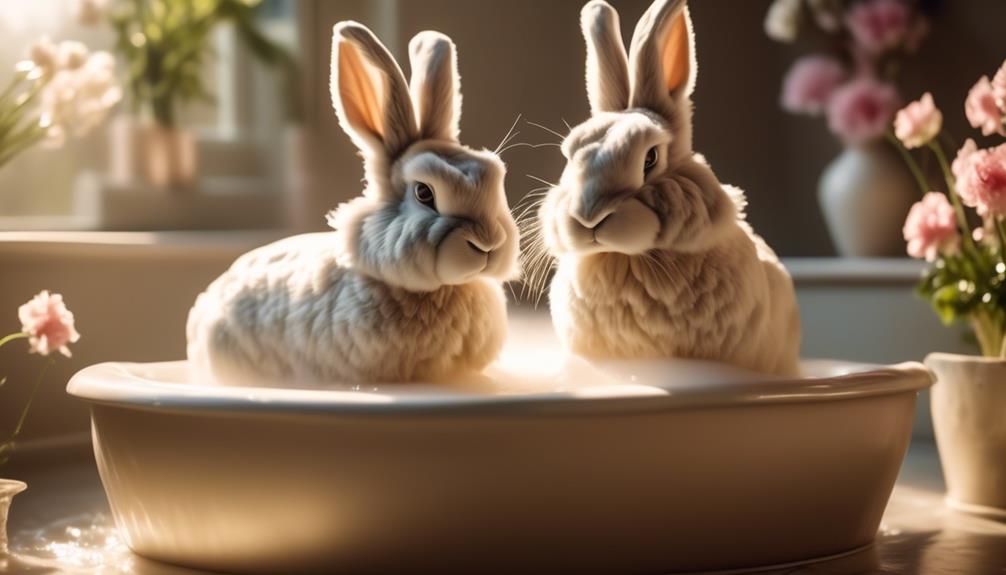
Caring for Satin rabbits involves providing proper socialization, suitable enclosures, a balanced diet, and regular health monitoring. Here are some care tips to keep your Satin rabbit healthy and happy:
- Socialization: Spend time with your Satin rabbit every day outside of its enclosure. This will help build a bond and prevent boredom or loneliness.
- Enclosure: Make sure the indoor enclosure has wire walls and a solid bottom to prevent escape and injury. Outdoor enclosures should be protected from extreme weather conditions.
- Diet: Offer a well-balanced diet consisting of 70% hay and 30% leafy greens, fruits, and vegetables. This will provide the necessary nutrients for your rabbit's overall health.
Remember to schedule regular check-ups with a veterinarian to monitor your Satin rabbit's health and address any potential issues promptly.
Frequently Asked Questions
Are Satin Rabbits Hypoallergenic?
Satin rabbits aren't hypoallergenic. Although their silky coats may seem less likely to cause allergies, it's important to note that allergies are usually triggered by a protein found in a rabbit's saliva, urine, or dander.
What Is the Average Cost of a Satin Rabbit?
The average cost of a satin rabbit can vary depending on factors such as location, breeder, and quality. It is best to research and contact local breeders or check online listings for current prices.
Can Satin Rabbits Be Litter Trained?
Yes, satin rabbits can be litter trained. Just provide a litter box with appropriate bedding, place it in their enclosure, and reward them for using it. Consistency and positive reinforcement are key.
Do Satin Rabbits Require Regular Grooming?
Yes, satin rabbits require regular grooming. Their silky, short fur with a satin sheen needs minimal maintenance. Brush with a slicker brush or run damp hands through the coat during heavy molt.
Are Satin Rabbits Good Pets for Children?
Satin rabbits make great pets for children! They have a silky coat that requires minimal grooming, and their friendly nature makes them perfect companions. Just remember to provide proper care and supervision.
Are Satin Rabbits Also Suitable for Indoor Living?
Yes, enchanting velveteen lop rabbits are suitable for indoor living. Satin rabbits, known for their shiny, silky fur, are a breed of rabbit that makes a great indoor companion. They are gentle, sociable, and easy to litter-train, making them ideal for living inside your home.
Conclusion
In conclusion, satin rabbits are truly stunning creatures with their silky coats and captivating sheen. With their medium-sized bodies and a lifespan of 7 to 9 years, they make wonderful companions.
Their coat, a result of a recessive sheen gene, requires minimal maintenance but regular health check-ups are important. Satin rabbits come in a variety of colors and have a rich breed history.
By providing them with daily socialization and a well-balanced diet, you can ensure that these beauties thrive in your care.

